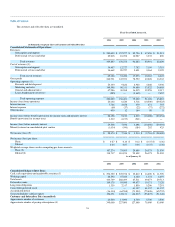Salesforce.com 2005 Annual Report Download - page 28
Download and view the complete annual report
Please find page 28 of the 2005 Salesforce.com annual report below. You can navigate through the pages in the report by either clicking on the pages listed below, or by using the keyword search tool below to find specific information within the annual report.
Table of Contents
We are dependent on our management team and development and operations personnel, and the loss of one or more key employees or groups could
harm our business and prevent us from implementing our business plan in a timely manner.
Our success depends largely upon the continued services of our executive officers and other key personnel, particularly Marc Benioff, our Chief
Executive Officer and Chairman of the Board, Steve Cakebread, our Chief Financial Officer, Jim Steele, our President of Worldwide Sales and Distribution,
Parker Harris, our Executive Vice President of Technology, Ken Juster, our Executive Vice President of Law, Policy and Corporate Strategy, and John
Freeland, our President of Worldwide Operations. We are also substantially dependent on the continued service of our existing development and operations
personnel because of the complexity of our service and technologies. We do not have employment agreements with any of our executive officers, key
management, development or operations personnel and, therefore, they could terminate their employment with us at any time. We do not maintain key person
life insurance policies on any of our employees. The loss of one or more of our key employees or groups could seriously harm our business.
Because competition for our target employees is intense, we may not be able to attract and retain the highly skilled employees we need to support
our planned growth.
To continue to execute on our growth plan, we must attract and retain highly qualified personnel. Competition for these personnel is intense, especially
for engineers with high levels of experience in designing and developing software and Internet-related services and senior sales executives. We may not be
successful in attracting and retaining qualified personnel. We have from time to time in the past experienced, and we expect to continue to experience in the
future, difficulty in hiring and retaining highly skilled employees with appropriate qualifications. Many of the companies with which we compete for
experienced personnel have greater resources than we have. In addition, in making employment decisions, particularly in the Internet and high-technology
industries, job candidates often consider the value of the stock options they are to receive in connection with their employment. Volatility in the price of our
stock may, therefore, adversely affect our ability to attract or retain key employees. Furthermore, the new requirement to expense stock options may
discourage us from granting the size or type of stock options awards that job candidates require to join our company. If we fail to attract new personnel or fail
to retain and motivate our current personnel, our business and future growth prospects could be severely harmed.
We might require additional capital to support business growth, and this capital might not be available.
We intend to continue to make investments to support our business growth and may require additional funds to respond to business challenges or
opportunities, including the need to develop new services or enhance our existing service, enhance our operating infrastructure or acquire complementary
businesses and technologies. Accordingly, we may need to engage in equity or debt financings to secure additional funds. If we raise additional funds through
further issuances of equity or convertible debt securities, our existing stockholders could suffer significant dilution, and any new equity securities we issue
could have rights, preferences and privileges superior to those of holders of our common stock. Any debt financing secured by us in the future could involve
restrictive covenants relating to our capital raising activities and other financial and operational matters, which may make it more difficult for us to obtain
additional capital and to pursue business opportunities, including potential acquisitions. In addition, we may not be able to obtain additional financing on
terms favorable to us, if at all. If we are unable to obtain adequate financing or financing on terms satisfactory to us, when we require it, our ability to continue
to support our business growth and to respond to business challenges could be significantly limited.
Changes in the accounting treatment of stock options will adversely affect our reported results of operations.
In December 2004, the Financial Accounting Standards Board, or FASB, announced its decision to require companies to expense employee stock
options. The pro forma disclosures that the FASB previously permitted
25
























